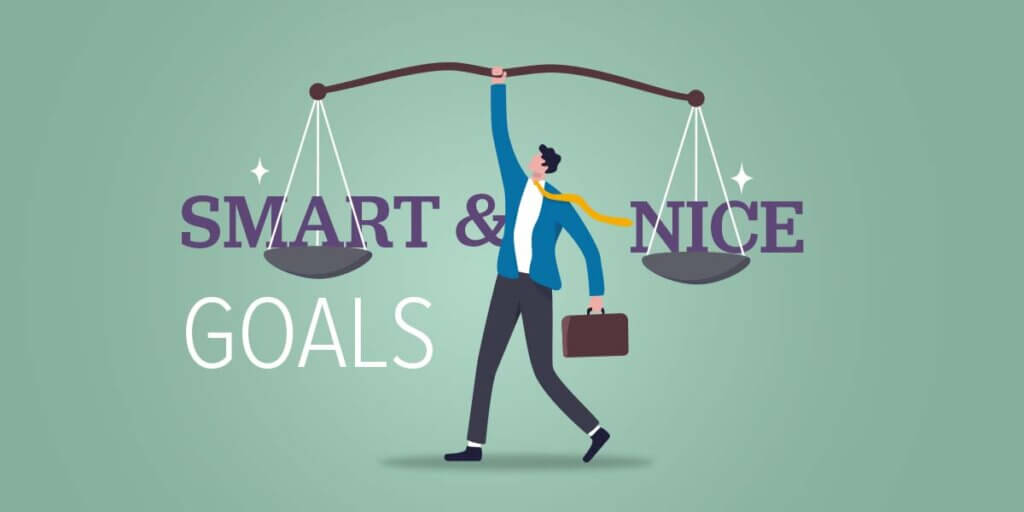SMART & NICE – Goals Gone Wild!
David Carnes | February 2024

Inspired by Abi Abdaal’s new book, Feel-Good Productivity, I’m testing a new goal-setting approach. This idea combines classic SMART goals with Abdaal’s preferred goal achievement framework, NICE.
So far, so good.
Most of us have heard of SMART Goals.
SMART goals are:
Specific – Who, what, when, where, why.
Your goal needs to be focused enough to enable planning and measurement. “I want to get in shape” is not as specific as “I want to do yoga 5 times a week so I’m more flexible and stronger.”
Measurable – You can’t improve what you don’t measure.
Be clear and quantifiable so you can answer, “Is this done, yes or no?” “Did I lose 20 pounds by July 1st?” “Did I complete my Google Ads certification by year-end?”
Achievable – Challenging but not impossible.
Going from 250 to 230 pounds in six months is challenging but possible. Going from 250 to 135 pounds in six months – not so much.
Relevant – Closely connected to a meaningful objective.
The goal needs to connect with you and your values. It should resonate with your identity and tie into a broader objective. A relevant goal with “Why” power behind it is potent. If you don’t believe it will impact your life and why you’re doing it, it will be harder to muster the energy to get it done.
Time-Bound – A due date holds you accountable.
A SMART goal has a completion date to focus you on getting it done. Without a written due date, goals are hard to prioritize. A date should be tied into the goal statement. “I will lose 20 pounds by July 1st.” Or, “I will sell 20 cars by 1/1/25.”
Abdaal’s NICE stands for:
Near-term – Daily or weekly goals.
Goals should be doable daily or weekly. This neatly avoids getting overwhelmed by the big picture.
Input-based – Specific simple actions.
This is about the process – rather than focusing on losing 20 pounds in six months, you focus on taking a half-hour walk before you eat.
Controllable – Under your control.
You need to be able to control your goal. Going for a half-hour walk is something you can control and schedule. Taking three hours for an occasional workout is not going to move the needle.
Energizing – Give it some juice.
What would it look like if the goal was fun to do? Is there a way to make that half-hour walk more pleasant and playful? Could a friend join you or listen to a great audiobook during the walk? Think about how to make the work more enjoyable and playful.
I love the combination of these two perspectives.
SMART creates clarity and vision around longer-term goals – like earning $100,000 in two years. SMART goals are visions of your future self and provide a destination. NICE is an encouraging framework that emphasizes the day-to-day things you can control. It focuses on enjoying the journey and having fun during the process.
Knowing where you’re going is essential – having a destination is SMART.
Enjoying the journey and making daily progress feels good and is NICE.
Combining these two approaches, we find magic in the ampersand – SMART & NICE. The “&” is the glue. The frameworks work.
Here’s a simple “SMART & NICE” practice to try:
- Determine your SMART goals and the related NICE goals.
- Write down your SMART goals and tell your friends about them. At the same time, create NICE goals that support your SMART goals.
- SMART Goal – Lose 20 pounds by July 1st.
- NICE Goal – Exercise at least 30 minutes daily, doing something fun, manageable, and sweaty.
Using a tracker to measure your progress on NICE goals is helpful and encouraging.
My current preferred method of NICE tracking is in my daily note-taking app, Roam.

Review and adjust how you did on a weekly basis. I do this on Sunday as I tackle my weekly time blocking. Blocking my time enables me to take control of my schedule. I ensure I am focused on the most important things and have time for my NICE goals each week. I use Google Calendar to manage the blocking.
My Roam-based habit/NICE tracker might be overkill for some people. My partner Lisa uses a paper calendar in her office to track her habits and daily goals. She draws symbols on days she does yoga or practices guitar and tries to keep her daily streaks going. This approach works for her. Experiment and find something that works for you to track your progress. I like Roam because I always have the app open throughout my day. Experiment and find your flow.
Take time once a calendar quarter to adjust your goals as needed. Celebrate the wins and acknowledge obstacles and lessons. Hint – this is more fun if you do it with a friend or an accountability partner.
Make course corrections and take time every year to think about how things are going. I like doing this around the New Year. Take a few days away from home. A different location will boost your dopamine and help you be more creative. Consider what’s important to you and what you want to achieve with your time on our troubled planet. What do you want to do with your life?
I’ve assembled a list of books that have inspired me to set goals in SMART & NICE ways. I keep them on my bookshelf to reference when I need a boost of motivation to keep me going.
SMART Resources
The Compound Effect by Darren Hardy
The 12 Week Year by Brian P. Moran
9 Things Successful People Do Differently by Heidi Grant Halvorson
Hell Yeah or No by Derek Sivers
NICE Resources
Feel-Good Productivity by Ali Abdaal
I hope this helps! If you find this helpful, have questions, or want to share your goal-setting tips and techniques, don’t hesitate to get in touch with me.
Don’t think twice; try SMART & NICE!
